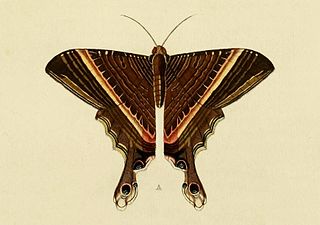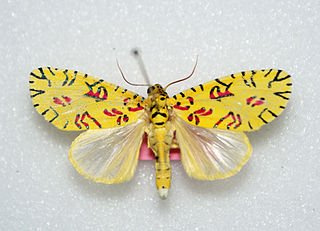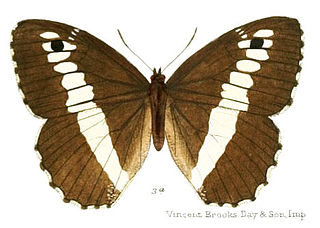Metachanda is the sole genus in tribe Metachandini of moth subfamily Oecophorinae. Metachandini was originally described as family Metachandidae by Edward Meyrick in 1911, and at the time also contained the genus Chanystis, which is currently unplaced to tribe within Oecophorinae. It has also previously been described as tribe Metachandini of subfamily Gelechiinae.

Sematuridae is a family of moths in the lepidopteran order that contains two subfamilies.

Sematurinae is a subfamily of moths in the family Sematuridae represented by at least 29 species in the Neotropics.

The blue tit is a species of lycaenid or blue butterfly found in parts of South Asia and Southeast Asia. It was traditionally called Chliaria kina but the genus Chliaria is merged into Hypolycaena by many recent authors.
Anathetis is a genus of moths of the family Noctuidae. The genus was erected by Anthonie Johannes Theodorus Janse in 1938.
Cingalesa is a monotypic moth genus of the family Noctuidae. Its only species, Cingalesa strigicosta, is found in Sri Lanka. Both the genus and species were first described by George Hampson, the genus in 1894 and the species in 1893.

Mazuca is a genus of moths of the family Noctuidae found in Sub-Saharan Africa. The genus was erected by Francis Walker in 1866.

Lepidopalpus is a monotypic moth genus in the subfamily Lymantriinae. Its only species, Lepidopalpus hyalina, is found in southern Africa. Both the genus and the species were first described by Anthonie Johannes Theodorus Janse in 1915.
Micraroa is a genus of moths in the subfamily Lymantriinae. The genus was erected by George Hampson in 1905. Both species are found in southern Africa.
Bylazora is a genus of moths in the family Geometridae described by Francis Walker in 1863.
Panagropsis is a monotypic moth genus in the family Geometridae described by Warren in 1894. Its only species, Panagropsis equitaria, described by Francis Walker in 1861, is found in South Africa.

Aulocera saraswati, the striated satyr, is a brown (Satyrinae) butterfly that is found in the Himalayas.

Aulocera brahminus, the narrow-banded satyr, is a brown (Satyrinae) butterfly that is found in the Himalayas. The species was first described by Émile Blanchard in 1853.
Spectroreta is a monotypic moth genus belonging to subfamily Drepaninae erected by Warren in 1903. Its only species, Spectroreta hyalodisca, was described by George Hampson in 1896.
Sorocaba is a monotypic moth genus of the family Phiditiidae. Its only species, Sorocaba anomala, is found in São Paulo, Brazil. Both the species and genus were described by Frederic Moore in 1882.

Snellenia is a genus of moths in the family Stathmopodidae.
Hyalaethea solomonis is a moth of the subfamily Arctiinae. It was described by George Hampson. It is found on the Solomon Islands.
Saurita mediorubra is a moth in the subfamily Arctiinae. It was described by William James Kaye in 1911. It is found in southern Brazil.

The genus Mania comprises a group of tropical and semi-tropical New World moths in the family Sematuridae. The genus has historically been referred to as either Nothus or Sematura, but both of these names are invalid.








